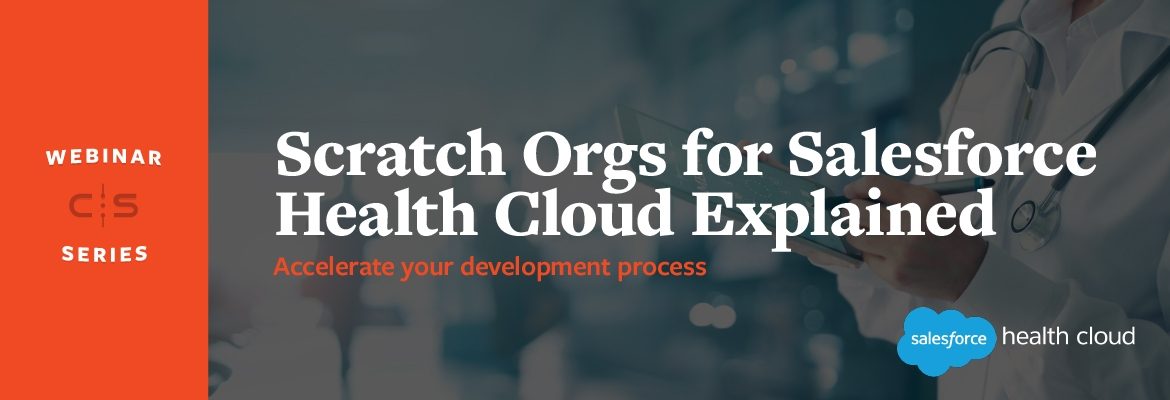
It wasn’t until the Summer ‘19 release that scratch orgs were available to use for Health Cloud. And due to the many custom configuration decisions that must be made when setting up Health Cloud, scratch orgs weren’t widely adopted.
With the pandemic of COVID-19, more and more companies are looking to build solutions that leverage Health Cloud and are looking for advice on how to do this quickly and effectively.
To help companies understand how to leverage scratch orgs for Health Cloud and the benefits they present, we’ve created this 30-minute technical webinar where we show you how to set up scratch orgs, the considerations you need to keep in mind along the way, and the most common gotchas that trip partners up along the way.
Register Here
How Scratch Orgs Simplify Your DevOps
One of the core benefits of scratch orgs is it allows you to take advantage of Salesforce DX — the modern development practices that Salesforce has put into place. Salesforce DX enables developers to spin up new orgs with everything provisioned.
Additionally, it solves some of the challenges presented by using a Dev Org — like remembering to move changes to source control as well as the complications of sharing a single environment with multiple developers and successfully doing change management.
Scratch orgs also let you capture the full picture of the Org you’re developing against. You’re not going to spend time worrying you missed some page layouts or someone adding a field in one org and not making its way to another. The ability to have Salesforce track your configuration and code changes behind the scenes — and being able to pull it down with a single command, expedite the development process.
Moreover, being able to verify when something is checked into source code, you can build an entirely clean org using something like continuous integration to automate many of the steps. That way, you’re not waiting as long for a scratch org on Health Cloud to be generated.
When it comes to testing orgs and testing the actual installation of your package, you can verify your subscribers aren’t going to run into any issues themselves when they go to install.
Lastly, this provides a closer integration with VSCode. You can spin up a scratch org, test something out, and push it live. Overall, this process cuts way down on the time needed when compared to metadata deployments. You are only getting and pushing the data you need rather than pulling and pushing everything.
Helpful Links and Tips as You Follow Along
It is important to note each developer’s use case of what they want to pull into their scratch org may vary. The customization is specific to you, and the purpose of this webinar is to smooth out the process as well as avoid common gotchas.
Here are a few places I’ve seen partners learn about the hard way, to hopefully help you avoid the same issues:
- Use a Partner Edition Org — Partner Edition orgs give you more users, more data, and allow you to use a greater feature set than other editions.
- There is only one Health Cloud license per scratch org, and those scratch orgs only exist for 30 days — this emphasizes the fact that source control remains the source of truth.
- Partner Developer scratch orgs only hold a limited amount of data (around 200mb of data). If you need to do testing with large data volumes, you’ll need to use something other than a scratch org.
- Health Cloud depends on quality data being loaded into scratch orgs to function properly. Using the proper toolset can make a huge difference in productivity.
Here is a collection of links I reference throughout the webinar. Do note links can change, and you should follow along with the webinar to understand what each is for.
- Enable Dev Hub in Your Org
- Scratch Org Definition File
- Health Cloud Managed Package — Current package id: 04t1C000000go7oQAA — however, this is regularly updated
- (If needed) Unmanaged extension packages
- Permission Set Groups
- SFDX-Wry-Plugin — For record type translation
- ETCopyData — A plugin to populate your scratch org with data extracted from multiple sObjects
- Further documentation around Health Cloud Environments for Partners
- A sample repo of Health Cloud metadata and config for spinning up scratch orgs
At CodeScience, we help our customers discover their greatest opportunity for building a Salesforce business — no matter if you’re starting out or have been a long time partner. Contact us today!


